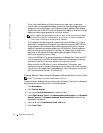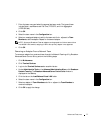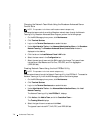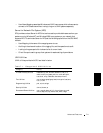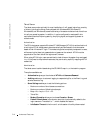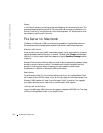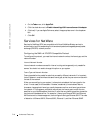
7-12 Advanced Features
www.dell.com | support.dell.com
Telnet Server
The telnet server works optimally for most installations. It will accept logins from a variety
of clients, including the telnet clients shipped with Windows 2000, Windows NT,
Windows 95, and Windows 98, as well as a variety of character mode terminal clients from
virtually any operating system. In addition, it can be configured to meet specific site
requirements such as improving security, simplifying logins, and supporting stream or
console mode.
Authentication
The SFU telnet server supports Windows NT LAN Manager (NTLM) for authentication of
client logins. NTLM allows users to be automatically authenticated to the telnet server
based on their Windows NT login. This makes using telnet completely transparent to users,
while ensuring that clear text passwords do not pass over the network. NTLM must be
supported on the client side of the login as well, however.
When using NTLM login, users are restricted to local drives on the system they are logged
in to. If they need to map network resources, they can do so by explicitly mapping with full
credentials.
Administration
The telnet server is administered using the SFU MMC snap-in, or the tnadmin program.
The options available are:
• Authentication gives you the choices of NTLM and Username/Password.
• Auditing enables you to set event logging to a separate log file, or the Event Log, and
set what events to log.
• Server Settings enables you to set the following options:
– Maximum number of simultaneous connections
– Maximum number of failed login attempts
– Map <Alt> key to <Ctrl><A>
–Telnet Port
– Mode of Operation allows you to choose Console or Stream.
– Default Domain Name is the domain name that is automatically added to the
login username. The default is “.”, which disables this feature.
– Idle Session Timeout is the time until an idle session is forcibly disconnected.





